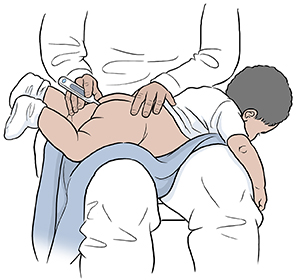Taking a Baby's Temperature
What type of thermometer should you use?
Always use a digital thermometer to check your child’s temperature. Never use a mercury thermometer. A digital thermometer makes taking a baby's temperature simple with quick results. Other types of thermometers may not be accurate for newborns. These include ear (tympanic) thermometers. They need to be carefully placed to get a precise reading. Skin strips that are pressed on the skin to measure temperature are not advised for babies. And keep in mind that touching a baby's skin can let you know if they are warm or cool. But you can't measure body temperature simply by touch.
Where should you take a baby's temperature?
There are 3 main places to take a baby’s temperature:
-
In the rectum. For best results in babies and toddlers up to 3 years of age, the American Academy of Pediatrics advises taking the temperature in the rectum. This is done by placing a thermometer in the baby's anus. This method is accurate and gives a quick reading of the baby's internal temperature. For infants and toddlers, be sure to use a rectal thermometer correctly. A rectal thermometer may accidentally poke a hole in (perforate) the rectum. It may also pass on germs from the stool. Follow the product maker’s directions for proper use. If you don’t feel OK taking a rectal temperature, use another method.
-
On the forehead. A newer method to take a temperature is called temporal artery thermometry. This is also very accurate. It measures the temperature of the blood flowing through the temporal artery, on the forehead. This causes less discomfort than a rectal thermometer. It's also less stressful to a newborn.
-
In the armpit. This is called axillary measurement. It may be used as a first way of checking to see if a child may have a fever. If this shows a fever, the temperature should then be checked by rectum or forehead.
Tips for taking a rectal temperature
Oral and rectal thermometers have different shapes and one should not be substituted for the other. Don't use oral thermometers rectally as these can cause injury. Rectal thermometers have a security bulb designed specifically for safely taking rectal temperatures.

-
Place the baby across your lap or changing table, on their belly, facing down. Place your hand nearest the baby's head on their low back. Push apart the baby's buttocks with your thumb and forefinger.
-
Using your other hand, gently insert the lubricated bulb end of the thermometer 1/2 inch to 1 inch, or just past the anal muscle.
-
Point thermometer towards the child's belly button.
-
Hold the thermometer with 1 hand on the baby's buttocks so the thermometer will move with the baby. Use the other hand to comfort the baby and prevent moving.
-
Never leave a baby unattended with a rectal thermometer inserted.
-
Hold the thermometer until it beeps or signals.
-
Remove the thermometer.
-
Wipe the bulb.
-
Read it right away. Write down the number.
-
Clean the thermometer with soap and water or rubbing alcohol.
Tips for taking a forehead temperature
-
Place the thermometer sensor in the middle of the baby's forehead.
-
Press and hold the scan button.
-
Slowly move the thermometer across the forehead toward the top of the baby's ear. Make sure it always touches the skin.
-
Stop at the hairline. Release the scan button.
-
Read the temperature.
When to call the healthcare provider
Call your baby's healthcare provider if a baby's rectal or forehead temperature is 100.4°F (38°C) or higher. Tell them which method you used to take your child’s temperature.
Online Medical Reviewer:
Donna Freeborn PhD CNM FNP
Online Medical Reviewer:
Heather M Trevino BSN RNC
Online Medical Reviewer:
Liora C Adler MD
Date Last Reviewed:
5/1/2022
© 2000-2025 The StayWell Company, LLC. All rights reserved. This information is not intended as a substitute for professional medical care. Always follow your healthcare professional's instructions.